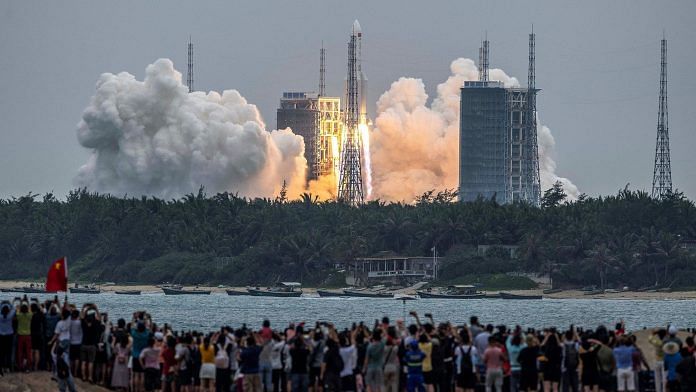Bengaluru: A large portion of a Chinese rocket is set to make an uncontrolled and unpredictable re-entry into the Earth’s atmosphere this weekend, and is likely to land in one of the oceans that cover 70 per cent of the planet.
The piece of debris is the core booster stage of the Long March 5B rocket that launched the Tianhe core module, the first module of the new Chinese space station Tiangong-3, on 29 April.
The stage is 30m (100 ft) long and weighs over 20,000 kg, making it among the largest and heaviest pieces of space debris to fall back to earth.
The China National Space Administration (CNSA) is yet to release any data about how controlled the re-entry is or what its trajectory is. According to the state-run newspaper Global Times, the “thin skinned” aluminium alloy exterior is expected to burn up in the atmosphere, but experts say many pieces of debris will survive the fall.
Plotting the exact trajectory of the debris is difficult due to too many uncertainties in atmospheric drag including the effects of the solar wind (plasma and particles from the sun) on the Earth’s atmosphere.
The current estimates for re-entry and crash are between 1.30pm UTC (7.30pm IST) on 8 May and 7.30pm UTC on 9 May (1.00am IST on 10 May).
The crash is expected to occur between latitudes 41.5 degrees north (running through North America, Southern Europe, and China) and 41.5 degrees south (through S. America, Africa, Australia, and NZ), as its orbital inclination is 41.5 degrees.
Our latest prediction for CZ-5B rocket body reentry is:
?09 May 2021 03:43 UTC ± 16 hours
Reentry will be along one of the ground tracks shown here. It is still too early to determine a meaningful debris footprint. Follow this page for updates: https://t.co/p2AU9zE3y2 pic.twitter.com/MgzRAOTJnk— The Aerospace Corporation (@AerospaceCorp) May 6, 2021
Also read: ‘Tow truck’ in space to remove debris — European agency announces first-of-its-kind mission
History of rocket stage falls
It is routine for every rocket stage to fall after jettisoning, once its fuel is burnt and the desired altitude is reached. For most rockets, this occurs immediately. Lower stages tend to burn up in the atmosphere, while upper stages that reach orbit will fire their engines after releasing their payloads, thus reorienting to reenter harmlessly over the ocean.
However, China has been criticised for its habit of not planning re-entry and letting rocket stages fall back to Earth at random.
Multiple routine falls have occurred in the country’s rural areas near rocket ranges before they were moved to coastal locations.
In 2020, another Long March 5B rocket carried out a test flight of a crew module, and its booster made an uncontrolled re-entry. Debris from this re-entry, such as rods, damaged buildings in two villages in the republic of Ivory Coast, in West Africa.
China’s first space station, Tiangong-1, crashed into the Pacific Ocean in 2016 after the country’s space agency lost control of it.
Later in 2019, the country performed a controlled re-entry of its second station, Tiangong-2, burning it up in the atmosphere over the Pacific Ocean.
Other space debris has occasionally fallen on land, such as a part of NASA’s Skylab space station that fell on a town in Australia in 1979, for which NASA was jokingly fined $400 by a local ranger for littering. The fine was paid 30 years later by a California radio host who crowdfunded the amount.
In March, debris from a SpaceX Falcon 9 rocket fell over a man’s farm in Washington State, US, creating a “4-inch dent in the soil”.
The heaviest space debris to fall back on Earth uncontrolled, before Ivory Coast, was the Russian Salyut 7 space station, weighing about 1,800 kg. It performed an uncontrolled entry over Argentina in 1991 with no retrievable debris.
Also read: How solutions found for space garbage could help fix the plastic problem on Earth
About Tiangong-3
The Tiangong-3 space station, which literally means “heavenly palace”, is expected to be more sophisticated than its earlier two prototypes.
The third version of this space station will weigh 66,000 kg and will begin operations by 2022 at an orbit of about 350-450km.
It is expected to be operational for 10 years. Its design contains multiple modules including the now-launched Tianhe core module, the Wentian science lab, the Mention science lab, the Shenzhou crew capsule or lifeboat, and the Tianzhou robotic cargo ship.
The core module contains the main living area for the future crew of the space station. It is 16.6m long and 4.2m wide, with life support. It will provide power and propulsion to the station.
China plans to launch the remaining modules over 10 launches or so over the next year.
(Edited by Rachel John)
Also read: It’s time to bring in regulation for outer space



